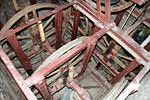Keyworth St Mary MagdaleneBells
 Bell frame Bell frame |
Bellringing
has always been a feature of the church and the tower has carried three bells
since the mid-17th century, the earliest of which dates from the late 16th
century, when it may have been rung to celebrate victory over the Spanish Armada.
However, the tower has always had the capacity for a peel of six bells, and
in 1992 a further three were installed at a cost of £10,000, covered
generously by two benefactors.
The western tower with octagonal belfry contains a ring of six bells, as follows:
| |
Decoration & Inscription |
Maker |
Date |
Size |
Weight |
| Treble E |
Oak Leaves
Glory to God in the Highest.
Given by
Alick and Peggy Lun
and
John & Jennifer Davie |
Taylors |
1992 |
25” |
3.1.26 |
| 2 D |
Oak leaves
God Save our Parish.
Bridgit Mary Pattinson |
Taylors |
1992 |
26.5” |
4.0.2 |
| 3 C |
Oak leaves
God Save our Queen and Country
Stuart John Robert Pattinson |
Taylors |
1992 |
27.5” |
4.1.8 |
| 4 B |
Running vine border
God Save His Church
W. Smith, W Seavvall, W. Rare |
Oldfield |
1652 |
29.5” |
4.2.1 |
| 5 A |
Cable border
God Save the Church |
Oldfield |
1628 |
32.5” |
5.2.24 |
| Tenor G |
God Save His Church Ovr Queen and Realme and Send vs Peace. Amen |
Quernbie |
Late C16 |
34.875” |
6.2.23 |
The six bells are hung in a cast iron frame for five bells with an extra low-sided
pit above for the sixth bell, all by Taylors in 1933. All the back three bells
are hung on canon-retaining metal headstocks and ball bearings. The three trebles
were added in 1992.
The fourth and fifth were the work of George (I) Oldfield, the treble in the
Commonwealth period. Both bells have the inscription in the small Roman letters
in word blocks, the fifth having a cable border. The tenor (No. 6) is an Armada
bell according to local tradition. The style of inscription certainly indicates
a date after 1553 when Mary came to the throne, so the bell is likely to be
the work of Robert Quernbie, the successor to Humphrey his father, who was
in turn son-in-law to Robert Mellours.
Ringing here has not always been safe, for in December 1626 the churchwardens
appeared in the Archdeacon’s Court “because there is no floore
sufficient under the bells, one of the bell clappers fell through by reason
of that defect and dangered the killing of a man”
A bell was recast here in 1608 for a local who appeared in the same court
paying part of his assessment “towards the bells recasting”.
|